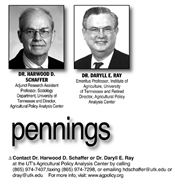|
Agriculture Faces Financial Pounding From Multiple Sources

With the appearance of COVID-19 earlier this winter, we believe that US agriculture has found itself in a multi-crisis situation.
We are facing the development of a farm financial crisis, the likes of which have not been seen since the 1980s and before that the farm crisis that began in the years following WWI and exploded during the early years of the Great Depression.
Over the last five years, crop and milk prices have plummeted to the point that they are significantly below the full cost of production. While there are differences with the 1980s – 1. lending is on the basis of cash flow and not the growth in assets and 2. interest rates are not in the stratosphere – the increasing number of bankruptcies among crop and dairy farmers provide clear signs that rougher times are still ahead of us. The recent Emergency (Market Facilitation) payments have put a band aid over the wound for some farmers but the fever of the underlying economic illness is still raging.
For many the widespread flooding of last spring provides a clear signal that climate change is real and will likely become more severe in coming years. Not all of us will agree on the cause of climate change but its presence is inarguable. In addition to more severe weather events like the Midwest flooding last year, we are seeing crops like corn being grown in areas where a couple decades ago the growing season was too short for corn production. Other areas may be too dry to grow their former crops. All of this creates a climate of uncertainty for farmers as weather variability exceeds recent norms.
The outbreak of COVID-19 in China will have an effect on agriculture. While we have enough meat in cold storage to meet the immediate needs, what procedures will be needed to ensure that processing plants that employ more than 10, or 20, or 50 people – the size limits for gatherings during the COVID-19 outbreak – will be able to operate and process animals that are ready for market? Certainly, safety measures for farmers, truckers, and processing plant workers will have to be in place. But, without a functioning processing industry, the farm-level impacts will be severe.
An additional issue in this area will be the movement of hogs and cattle across the borders the US has with Mexico and Canada as processors have developed a North American meat industry.
Last week’s column talked about the continued availability of fresh fruits and vegetables for consumers in the US. As the seasonal production of these crops shifts to the US, farmers will face the challenge of finding enough workers to harvest the crops. Will the US allow enough experienced guest workers into the country under H2A visas to harvest the crop? Will we have to appeal to unemployed US workers who have been laid off as restaurants, bars and other employers have had to close their businesses? Finding the labor to work the fields will be more difficult than growing the crop.
Robust local food markets have developed around most urban centers. These markets provide income for farmers who provide locally grown fruits and vegetables, milk, and meats. In many cases the products have been sold to the restaurant industry. With the closure of restaurants and bars in many areas, the income stream for these farms will be endangered. The challenge will be to find additional outlets for this production. In addition, these sellers will have to protect themselves and their customers from the inadvertent transmission of the COVID-19 virus.
The corn-to-ethanol industry is facing a double whammy at this time. The Administration has allowed additional waivers of the blend rule, reducing the amount of ethanol required to be blended into the nation’s fuel supply. At the same time with the reduction in commuting to work, less vacation travel and sheltering in place will the amount of E-10 gasoline purchased by US consumers will be significantly reduced.
Perhaps the wiping out of the supply of sanitizing alcohol gel could provide an opportunity for converting a slight portion of the surplus ethanol into hand sanitizer gel. At the time this column is being written most retail outlets have no hand sanitizer to offer their customers.
As Congress and the Administration work on emergency packages to address the impact of the COVID-19 crisis we hope that the needs of agriculture will be addressed in the final forms of the legislation. ∆
DR. HARWOOD D. SCHAFFER: Adjunct Research Assistant Professor, Sociology Department, University of Tennessee and Director, Agricultural Policy Analysis Center
DR. DARYLL E. RAY: Emeritus Professor, Institute of Agriculture, University of Tennessee and Retired Director, Agricultural Policy Analysis Center
|
|